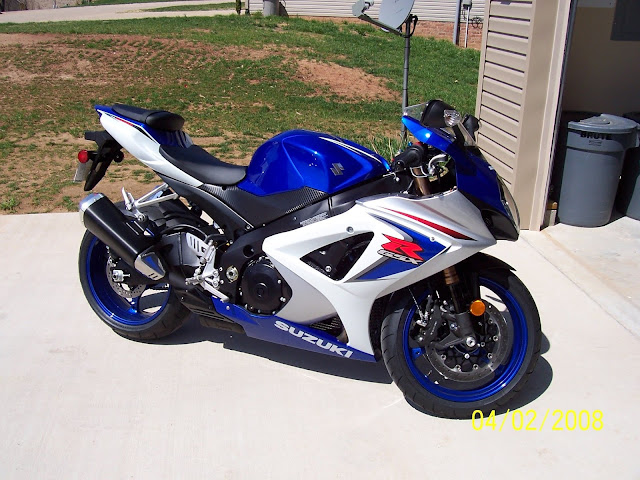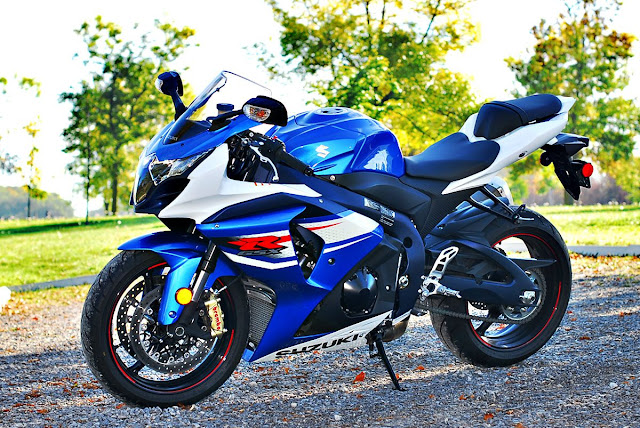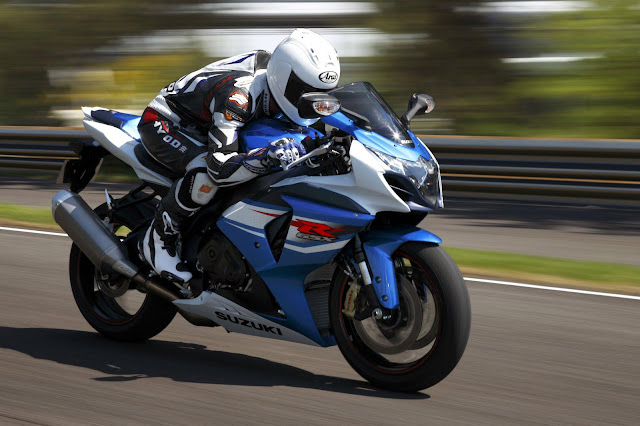Suzuki GSX-R1000
The GSX-R1000 was distinguishable from its lookalike 750 and 600cc siblings by six-piston front brake calipers and gold- coated fork sliders. And, of course, by the way it tried to tear its rider’s arms off when the throttle was opened.
At the start of the new millennium, many I sport bike enthusiasts accepted that the era of dramatic performance increases from production machines was over. After the big gains made by Honda’s CBR900RR in 1992 and Yamaha’s R1 six years later, they felt it would not be possible for a mass-produced bike to make such a leap again. Then Suzuki’s GSX-R1000 burst onto the scene, with a devastating combination of speed and agility that left the opposition reeling and proved that the performance race was by no means over yet.
There was nothing revolutionary about this latest GSX-R, which looked so like its 750 and 600cc siblings that all three were difficult to distinguish at a glance. But there was simply no other bike on the road that came close to matching the big Suzuki’s blend of monstrously powerful engine, razor-sharp handling, fierce braking and light weight.
The GSX-R 1000’s 998cc engine was essentially a bored and stroked version of the most recent GSX-R750 unit, and shared some parts including much of its cylinder head with the smaller motor. Even the valves and their angles were identical, though the 1000’s camshafts gave revised lift and duration. The four-into-one exhaust system featured downpipes made from lightweight titanium, plus a Yamaha-style exhaust valve for added midrange performance. Peak output was 161 bhp at 1 l,000rpm, giving the Suzuki a lObhp advantage over its closest open-class super-sports rivals, Honda’s FireBlade and Yamaha’s R1.
Frame geometry and riding position were unchanged from the 750, but the 1000‘s aluminium frame beams had slightly thicker outside walls.
Even the fairing was almost identical to the 750’s, but the new bike was distinguishable by its gold- finished, titanium nitride coated upside-down forks and its six-piston front brake calipers. The bigger bike also had a wider. 190-section tyre.
From the moment that the GSX-R 1000 was unleashed, there was little doubt that the superbike balance of power had shifted again. The engine's performance was awe inspiring, with a blend of savage top-end power, strong midrange and precise throttle control. There was no step or dip in its power delivery: just massive torque everywhere between 3000rpm and the 12,500rpm redline. In the right conditions the GSX-R was capable of a genuine 185mph (298km/h). and it got there mighty quickly.
The Suzuki’s chassis was every bit as impressive as its engine. At 3741bs (170kg) this 1-litre bike was only 91bs (4kg) heavier than the GSX-R750, and gained an advantage thanks to superior suspension and brakes. Both front and rear units were very progressive, soaking up small bumps and giving precise feedback. The six-piston front brake calipers delivered massive stopping power with good feel and minimal fork dive.
In typical GSX-R fashion, the new bike was unashamedly racy and single-minded. That was hardly a fair criticism; a more valid one was that this largest GSX-R, although by no means unattractive, looked rather ordinary. But the bottom line was that for pure performance, the GSX-R 1000 was the best bike in the world - by a distance.
Staying ahead: the Revamped GSX-R
Having built the world's fastest super-sports bike, Suzuki did not sit back but instead followed it by unveiling comprehensively revised models in 2003 and '05 to keep the GSX-R at the front of the pack. The GSX-R1000 K5 of 2005, in particular, combined a highest-yet power output of 176bhp with even sharper handling from a more compact chassis. The GSX-R brought well-deserved success on the racetrack in that year, too, most notably when Australian Troy Corser rode one to Suzuki's first ever World Superbike Championship.
This GSX-R is fitted with the pillion pad instead of the seat cover. Its exhaust is the standard system instead of the aftermarket pipe pictured opposite.
Suzuki’s 1993 500cc world champion Kevin Schwantz makes the most of the GSX-R’s cornering ability’ during a GSX-R festival day at Brands Hatch.
Specification Suzuki GSX-R1000 (2001)
- Engine Liquid-cooled dohc 16-valve four
- Capacity 998cc (73 x 59mm)
- Maximum power 161bhp @ 11,000rpm
- Transmission Six-speed, chain final drive
- Frame Aluminium twin spar
- Suspension Telescopic front; single shock rear
- Brakes Twin discs front; disc rear
- Weight 374lb (170kg)
- Top speed 185mph (298km/h)























0 comments: